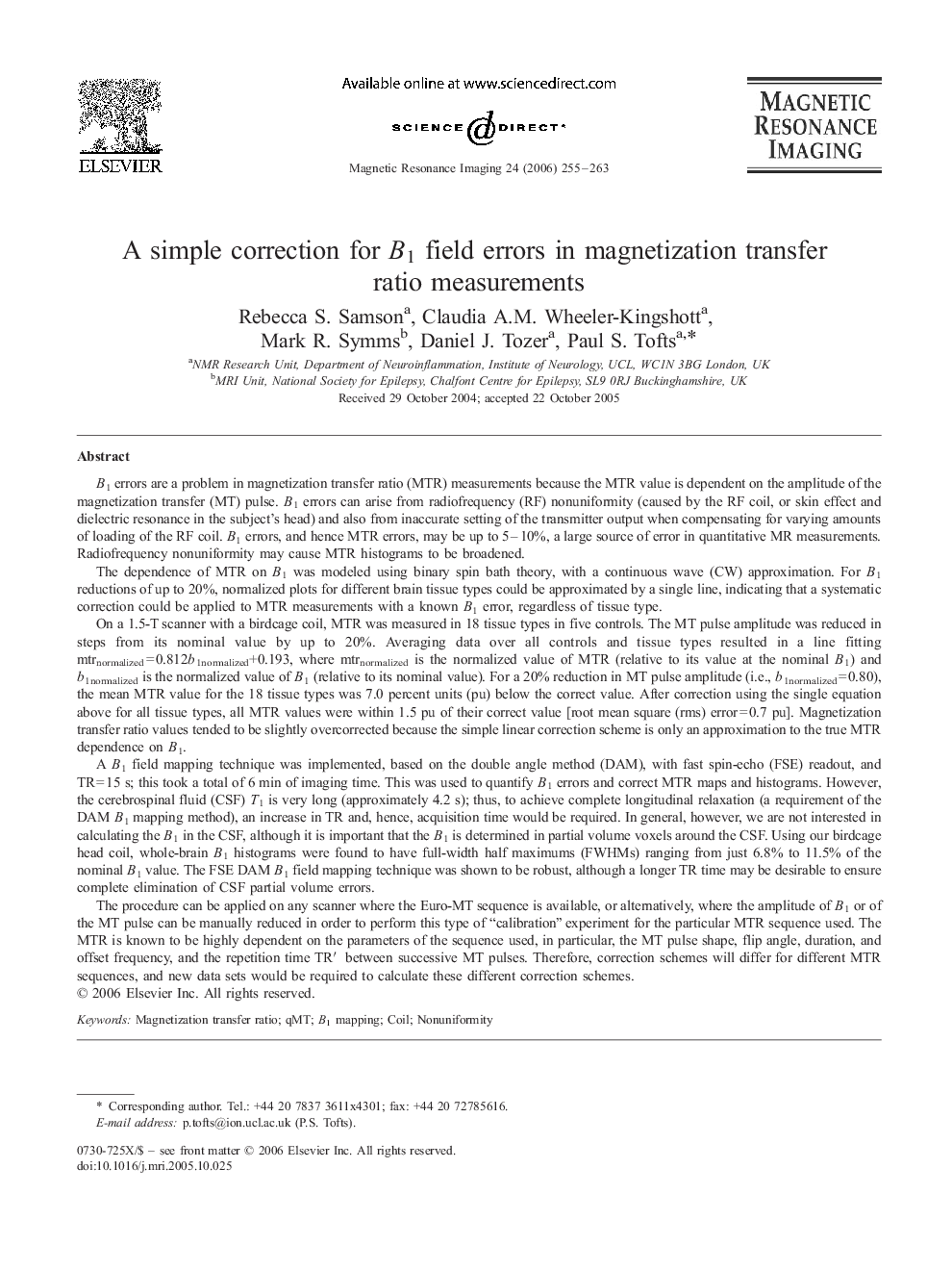| کد مقاله | کد نشریه | سال انتشار | مقاله انگلیسی | نسخه تمام متن |
|---|---|---|---|---|
| 1808119 | 1025319 | 2006 | 9 صفحه PDF | دانلود رایگان |

B1 errors are a problem in magnetization transfer ratio (MTR) measurements because the MTR value is dependent on the amplitude of the magnetization transfer (MT) pulse. B1 errors can arise from radiofrequency (RF) nonuniformity (caused by the RF coil, or skin effect and dielectric resonance in the subject's head) and also from inaccurate setting of the transmitter output when compensating for varying amounts of loading of the RF coil. B1 errors, and hence MTR errors, may be up to 5–10%, a large source of error in quantitative MR measurements. Radiofrequency nonuniformity may cause MTR histograms to be broadened.The dependence of MTR on B1 was modeled using binary spin bath theory, with a continuous wave (CW) approximation. For B1 reductions of up to 20%, normalized plots for different brain tissue types could be approximated by a single line, indicating that a systematic correction could be applied to MTR measurements with a known B1 error, regardless of tissue type.On a 1.5-T scanner with a birdcage coil, MTR was measured in 18 tissue types in five controls. The MT pulse amplitude was reduced in steps from its nominal value by up to 20%. Averaging data over all controls and tissue types resulted in a line fitting mtrnormalized=0.812b1normalized+0.193, where mtrnormalized is the normalized value of MTR (relative to its value at the nominal B1) and b1normalized is the normalized value of B1 (relative to its nominal value). For a 20% reduction in MT pulse amplitude (i.e., b1normalized=0.80), the mean MTR value for the 18 tissue types was 7.0 percent units (pu) below the correct value. After correction using the single equation above for all tissue types, all MTR values were within 1.5 pu of their correct value [root mean square (rms) error=0.7 pu]. Magnetization transfer ratio values tended to be slightly overcorrected because the simple linear correction scheme is only an approximation to the true MTR dependence on B1.A B1 field mapping technique was implemented, based on the double angle method (DAM), with fast spin-echo (FSE) readout, and TR=15 s; this took a total of 6 min of imaging time. This was used to quantify B1 errors and correct MTR maps and histograms. However, the cerebrospinal fluid (CSF) T1 is very long (approximately 4.2 s); thus, to achieve complete longitudinal relaxation (a requirement of the DAM B1 mapping method), an increase in TR and, hence, acquisition time would be required. In general, however, we are not interested in calculating the B1 in the CSF, although it is important that the B1 is determined in partial volume voxels around the CSF. Using our birdcage head coil, whole-brain B1 histograms were found to have full-width half maximums (FWHMs) ranging from just 6.8% to 11.5% of the nominal B1 value. The FSE DAM B1 field mapping technique was shown to be robust, although a longer TR time may be desirable to ensure complete elimination of CSF partial volume errors.The procedure can be applied on any scanner where the Euro-MT sequence is available, or alternatively, where the amplitude of B1 or of the MT pulse can be manually reduced in order to perform this type of “calibration” experiment for the particular MTR sequence used. The MTR is known to be highly dependent on the parameters of the sequence used, in particular, the MT pulse shape, flip angle, duration, and offset frequency, and the repetition time TR′ between successive MT pulses. Therefore, correction schemes will differ for different MTR sequences, and new data sets would be required to calculate these different correction schemes.
Journal: Magnetic Resonance Imaging - Volume 24, Issue 3, April 2006, Pages 255–263